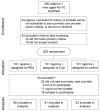Low-literacy interventions to promote discussion of prostate cancer: a randomized controlled trial
- PMID: 17673094
- PMCID: PMC1986767
- DOI: 10.1016/j.amepre.2007.03.018
Low-literacy interventions to promote discussion of prostate cancer: a randomized controlled trial
Erratum in
- Am J Prev Med. 2008 Mar;34(3):270. Jacobson, Terry A [added]
Abstract
Background: Professional organizations recommend that physicians discuss prostate cancer with patients to make individual screening decisions. However, few studies have tested strategies to encourage such discussions, particularly among high-risk populations. We examined the effects of two low-literacy interventions on the frequency of prostate cancer discussion and screening.
Design: Randomized, blinded, controlled trial with concealed allocation.
Setting/participants: Inner-city primary care clinic, serving a predominately African-American population. Participants were men aged 45-70 with no history of prostate cancer, presenting for a regular appointment.
Interventions: While waiting to see their physician, patients received a patient education handout on prostate cancer screening (PtEd), a handout simply encouraging patients to talk to their doctor about prostate cancer (Cue), or a control handout. The interventions did not advocate for or against screening.
Measures: Patient-reported discussion of prostate cancer with the physician and chart reviews determine prostate-specific antigen (PSA) test orders and performance of digital rectal examination (DRE). Adjusted odds ratios (aOR) and 95% confidence intervals (CI) were computed. Data were collected in 2003, and analyses were completed in 2006.
Results: Most of the 250 subjects (90.4%) were African American and 78.8% read below the ninth grade level. Overall, 48.4% reported discussing prostate cancer during the appointment. Compared to the control group (37.3%), discussions were significantly more common in the Cue group (58.0%, aOR=2.39 [1.26-4.52]), as well as in the PtEd group (50.0%, aOR=1.92 [1.01-3.65]). When prostate cancer was discussed, patients in the intervention groups more commonly initiated the conversation (47.6% PtEd and 40.0% Cue, vs 9.7% control, p<0.01 for each comparison to control). Compared to the control group (2.4%), PSA test orders increased in the PtEd group (14.1%, aOR=7.62 [1.62-35.83]) and in the Cue group (12.3%, aOR=5.86 [1.24-27.81]). Documentation of DRE did not change significantly (4.7% PtEd, 6.2% Cue, and 6.0% control).
Conclusions: Two simple low-literacy interventions significantly increased discussion of prostate cancer and PSA test orders but not performance of DRE. Both interventions were effective in empowering low-literacy patients to initiate conversations about prostate cancer with their physician.
Trial registration: ClinicalTrials.gov NCT00208988.
Conflict of interest statement
No financial conflict of interest was reported by the authors of this paper.
Figures




References
-
- Jemal A, Siegel R, Ward E, et al. Cancer statistics, 2006. CA Cancer J Clin. 2006;56(2):106–130. - PubMed
-
- Barry MJ. Clinical practice. Prostate-specific-antigen testing for early diagnosis of prostate cancer. N Engl J Med. 2001;344(18):1373–1377. - PubMed
-
- Burack RC, Wood DP., Jr Screening for prostate cancer. The challenge of promoting informed decision making in the absence of definitive evidence of effectiveness. Med Clin North Am. 1999;83(6):1423–1442. - PubMed
-
- U.S. Preventive Services Task Force. Screening for prostate cancer: recommendation and rationale. Ann Intern Med. 2002;137:915–916. - PubMed
Publication types
MeSH terms
Substances
Associated data
Grants and funding
LinkOut - more resources
Full Text Sources
Medical
Research Materials
Miscellaneous

